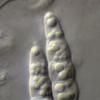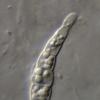
21-12-2025 09:32
Hello.A tiny ascomycete found embedded in wood in

21-12-2025 21:32
Pol DebaenstHello, Garden, Burgweg 19, Veurne, BelgiumOn 10/1

22-12-2025 23:38
Patrice TANCHAUDBonsoir, récolte sur un mur en pierre, apothéci

22-12-2025 00:47
Patrice TANCHAUDBonsoir, récolte à proximité du milieu dunaire

21-12-2025 21:40
Isabelle CharissouBonjour, j'aimerais connaitre les références de

20-12-2025 23:08
Patrice TANCHAUDBonsoir, récolte sur sol sablonneux dans l'arri�
Lophiostoma myriocarpum
Chris Yeates,
06-10-2014 20:36
 Bonsoir tous
Bonsoir tousI recently collected a partially-decorticated twig in woodland near a stream. I originally suspected that it might be a Chaetosphaeria, but under the microscope it was clearly not - fissitunicate asci proved that. Many, but by no means all, of the perithecia were somewhat laterally compressed and I considered Lophiostoma. Holm & Holm 1988 (Symb. Bot. Upsal. XXVIII) led me to Lophiostoma myriocarpum; the description fitted well, although the accompanying drawing (from the type collection) was not very convincing.
ASCOFrance came to the rescue in the form of Alain and Zotto:
http://www.ascofrance.com/search_forum/7390
I am pretty certain that my fungus is indeed Lophiostoma myriocarpum (or at the very least the same as Alain's fungus, although his spores are longer), this based on the narrowly fusoid multiguttulate spores 27.6-30.8 x 4.8-5.5µm. These were mostly 5-septate, though some were seen with up to 7 septa (the latter could be seen germinating from the polar cells - see the last photo).
As far as I can tell this taxon has not been recorded for Great Britain & Ireland, although there are two records for Lophiostoma vigheffulense (Pass.) Chesters & A.E. Bell. Holm & Holm suggest the two are conspecific - though the spore dimensions given in Chesters and Bell (Mycol. Pap. 120) are smaller and their drawing shows consistently 3-septate spores, with the comment that these are not constricted at the septa.
As ever comments and suggestions are more than welcome.
Cordialement
Chris




